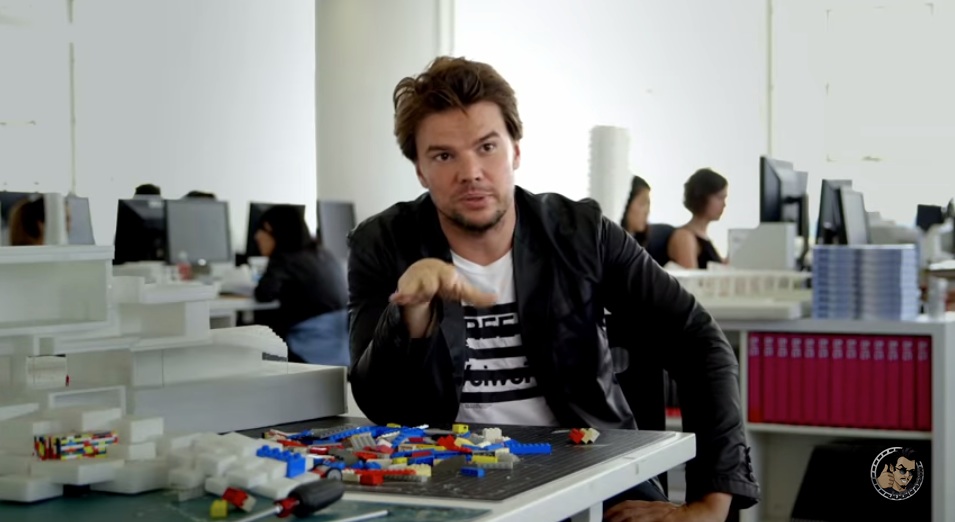Over a five-day period last month, as part of the Milan Expo 2015 in Italy, a slim tower made from more than 500,000 Lego bricks rose to 35 meters (114.8 feet), setting a new Guinness World Record as the tallest structure built with those familiar acrylic bricks.
Denmark-based Lego Group donated 7 Euros (US$7.752) for every centimeter of the tower to Urban Oasis, an urban protection and development project connected with the World Wildlife Fund.
That tower offered one more example of the role that Legos have played in the worlds of construction and creativity since the company’s founding in 1932. Last month, Lego Group, the company that makes the toy bricks, established its Lego Sustainable Materials Centre, and announced that it would invest 1 billion Danish Krone (US$148 million) for research, development, and implementation of sustainable raw materials to make Lego bricks and packaging.
In the documentary, Bjarke Ingels—whose eponymous firm is based in Copenhagen, Denmark—notes that, because of its harsh climate and high labor wages, much of what gets built in that country must be prefabricated to shorten the construction time.
The company has also teamed with Warner Bros., Interactive Entertainment, and TT Games to release an interactive video game that allows players to use Lego building sets digitally to build and create “wherever their skills and imagination roam,” says its press release.
“Our goal is to inspire and develop the builders of tomorrow,” said Lego Group’s owner Kjeld Kristiansen. “We believe that our main contribution to this is through the creative play experiences we provide to children.”
On July 31, a documentary film called "A Lego Brickumentary" will be released in the United States. Its narrator, the actor Jason Bateman, says it’s a story “about a simple toy and how its unique properties ushered in a new era of creativity for a whole generation.”
Along with a host of inventors and toy aficionados, the film interviews such Lego lovers as Facebook’s cofounder Mark Zuckerberg and Houston Rockets’ center Dwight Howard. Also featured prominently is starchitect Bjarke Ingels, who recounts how he won one of his first commissions by designing a model using Legos.
In the documentary, Ingels—whose eponymous firm is based in Copenhagen, Denmark—notes that, because of its harsh climate and high labor wages, much of what gets built in that country must be prefabricated to shorten the construction time. “In a manner of speaking, Denmark has become a country entirely built out of Legos,” he says in a clip of the film that Wired magazine posted on its site.
The Lego Group chose Ingels’ firm to design its Lego House, a 12,000-sm (129,167-sf), 23-meter-tall educational center in Billund, Denmark, whose purpose, in Kristiansen’s words, is “give us the opportunity to show how children learn through Lego play, and at the same time we can tell the Lego history in an involving way which reflects our values. Lego House is scheduled to open next year, but in the interim Lego Group will send a 1:100 scale model to six different fan events around the world. The model—built from 18,000 Lego bricks, of course—was seen by about 20,000 people who recently attended the largest Lego fan exhibition in Switzerland.
Related Stories
| Oct 14, 2011
BD+C Survey on Building Information Modeling: The Good, the Bad, and the Solutions
In a recent survey conducted by Building Design+Construction, more than 75% of respondents indicated they currently use BIM or plan to use it. Respondents were also asked to comment on their experiences with BIM, what they liked and disliked about BIM, and what BIM-related advice they would give to their peers.
| Oct 12, 2011
BIM Clarification and Codification in a Louisiana Sports Museum
The Louisiana State Sports Hall of Fame celebrates the sporting past, but it took innovative 3D planning and coordination of the future to deliver its contemporary design.
| Oct 5, 2011
GREENBUILD 2011: Johnson Controls announces Panoptix, a new approach to building efficiency
Panoptix combines latest technology, new business model and industry-leading expertise to make building efficiency easier and more accessible to a broader market.
| Oct 5, 2011
GREENBUILD 2011: Software an architectural game changer
Interactive modeling software transforms the designbuild process.
| Sep 12, 2011
Geist opens European branch
The new branch provides the company’s international clients with additional support and services.










